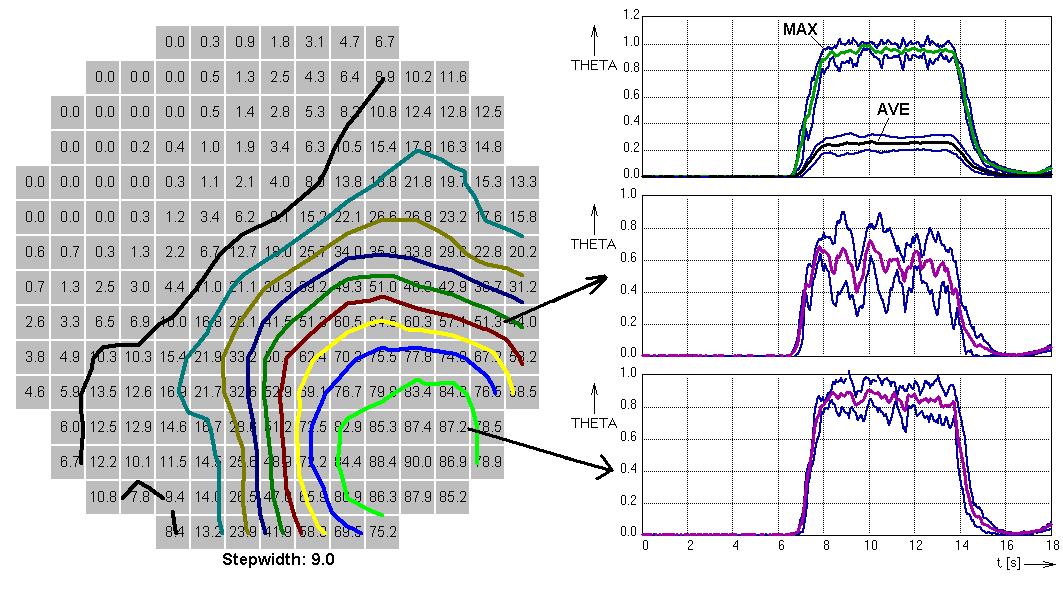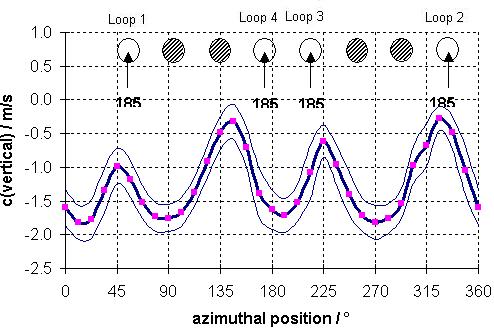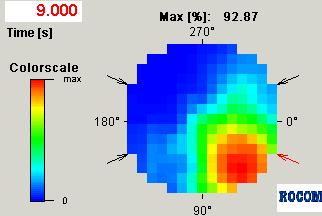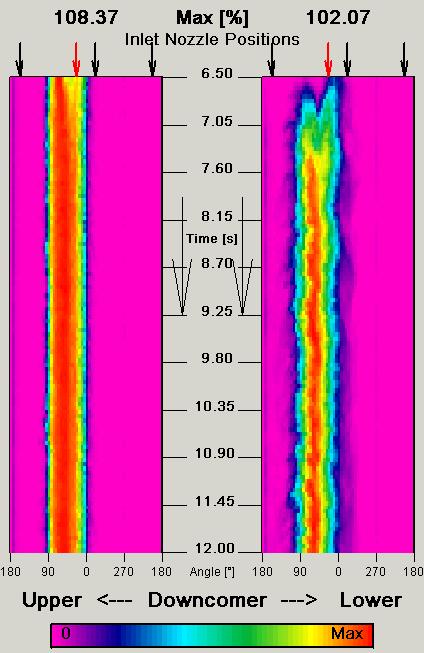Coolant mixing in stationary flow regimes
This work was carried out in the frame of the project "Coolant mixing in pressurized water reactors" (registration number: 1501216) funded from 01.04.1998 to 31.05.2002 by the German Federal Ministry of Economics and Labour.
Background
Flow distribution in the primary circuit of pressurized water reactors is an important issue connected to different operational problems. For instance, the quasi-steady flow with macroscopic oscillating swirls inside the reactor pressure vessel can cause temperature fluctuations and therefore is of importance to long-term thermal fatigue. The flow distribution at the core inlet is influenced by the flow field in the reactor pressure vessel and the flow distribution between the loops. An asymmetric loop flow distribution is possible for example due to the pump operation uncertainties during power operation or due to the total pump failure during accident scenarios.
Asymmetric temperature distributions between the loops can occur during overcooling scenarios. Such overcooling scenarios are mainly connected with steam line breaks. Inadvertent opening of turbine valves or other valves in the secondary circuit of a NPP are characterized by the same consequences and phenomena. The mixing of the loop flows before the core inlet must be properly known in order to correctly predict the reactivity margin or the power excursion of the core.
Asymmetric temperature distributions between the loops can occur during overcooling scenarios. Such overcooling scenarios are mainly connected with steam line breaks. Inadvertent opening of turbine valves or other valves in the secondary circuit of a NPP are characterized by the same consequences and phenomena. The mixing of the loop flows before the core inlet must be properly known in order to correctly predict the reactivity margin or the power excursion of the core.
Boundary conditions for the ROCOM experiments
Experiments have been carried out with variation of the flow rates in the single loops between 0 and 160 % of the nominal flow rate.
The experiment with nominal flow rates in all loops is selected as an example. In that experiment, constant flow rates are set in all four loops corresponding to the nominal values. Tracer injection over several seconds simulating the overcooling is performed into the flow of loop N° 1.
The experiment with nominal flow rates in all loops is selected as an example. In that experiment, constant flow rates are set in all four loops corresponding to the nominal values. Tracer injection over several seconds simulating the overcooling is performed into the flow of loop N° 1.
Results

Fig. 3: Plateau averaged distribution of the perturbation in the core inlet plane (left) and time evolution of the perturbation at different positions in the core inlet plane including confidence intervals
Velocity distributionFig. 4 shows the measured by a laser Doppler anemometer vertical component of the velocity in the experiment with nominal flow rate in all four loops together with the confidence interval of 68.3 % (Negative values mean downwards directed flow!). It is clearly to be seen, that the velocity heavily depends on the measurement position on the circumference. At the positions 0 °, 90 °, 180 ° and 270 °, that means in the middle between two neighboring inlet or outlet nozzles, a maximum of the velocity is observed. Minima of the velocity are measured at the positions between the above mentioned angle positions (45 °, 135 °, 225 ° and 315 °). The non-uniformity of the velocity field at the outlet of the downcomer is caused by a group of eight recirculating swirls, forming up below the inlet nozzle region. The appearance of these secondary vortices is induced by the widening of the downcomer in the region below the inlet nozzles. The width of the downcomer is increased by the reduction of the wall thickness of the vessel. The resulting diffuser angle of 18 deg is too big to avoid flow separation.
|
 Fig. 4: Measured velocity in z-direction (along an azimuthal line at the outlet of the downcomer, negative values indicate downwards directed flow) |
Publications
- G. Grunwald, T. Höhne, H.-M. Prasser, F.-P. Weiss
Coolant Mixing in Pressurized Water Reactors at Constant Coolant Flow in the Primary Circuit
Proc. Annual Meeting on Nuclear Technology '00, pp. 109-114, INFORUM GmbH, Bonn (2000)
- T. Höhne, G. Grunwald, H.-M. Prasser
Experimental Investigations on the Four-Loop Test Facility ROCOM
Kerntechnik 65/5-6, pp. 212-215 (2000)
- G. Grunwald, T. Höhne, S. Kliem, H.-M. Prasser, K.-H. Richter, U. Rohde, F.-P. Weiss
Versuchsanlage ROCOM zur Untersuchung der Kühlmittelvermischung in Druckwasserreaktoren - Ergebnisse quasi-stationärer Vermischungsexperimente
Report FZD-348, ISSN 1437-322X, 92S., Rossendorf (2002)
- H.-M. Prasser, G. Grunwald, T. Höhne, S. Kliem, U. Rohde, F.-P. Weiss
Coolant mixing in a PWR - deboration transients, steam line breaks and emergency core cooling injection - experiments and analyses
Nuclear Technology, vol. 143 (1), pp. 37-56 (2003)
- H.-M. Prasser, T. Höhne, S. Kliem, U. Rohde, F.-P. Weiss
Untersuchung der Kühlmittelvermischung an der Versuchsanlage ROCOM - Experimente und Modellierung
Annual Meeting on Nuclear Technology '03, Proc. Topical Session: "Experimental and theoretical investigations on boron dilution transients in PWRs" pp. 57-83, INFORUM GmbH Berlin, (2003)



